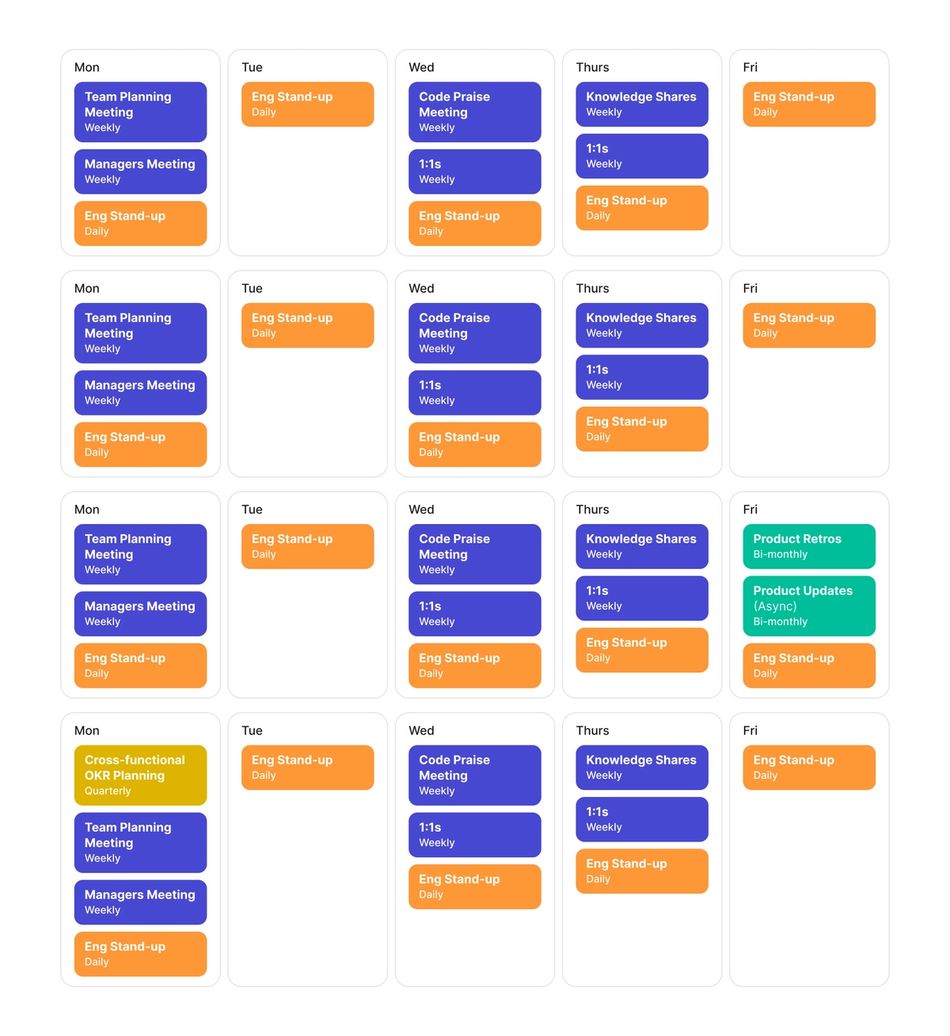Leading a team, especially a distributed or growing one, can be hard. Oftentimes the best advice and ideas come from other teams just like yours. That’s why we launched Lead Time: How Teams Work. This blog series profiles real teams, how they’re structured, and how they communicate through meetings and other touchpoints. Plus, each article features a top-notch leader who's got proven tips and real stories to learn from.
Meet Katie Wilde, VP of Engineering at Ambassador Labs
Katie leads the engineering org at Ambassador Labs. The team is global, remote, and extremely cross-functional in nature, partnering with peers in design and product on a daily basis.
We sat down with Katie to learn about what her team’s product cycle looks like and what meetings she says are must-haves for a remote eng org.
How the team works
Team structure
Katie’s engineering team consists of 39 ICs and 6 eng managers, who report directly to Katie. They work on cross-functional sub-teams, responsible for different areas of the product, consisting of engineers, product managers, and designers.
Team meetings and communication cadence
The team operates on 6-week product cycles. Here’s a sample of their meeting and communication cadence over that time period.

Daily:
- Product stand-ups: Each sub-team holds their own daily stand-up. Some teams do stand-ups asynchronously, using a Slackbot, and some do it over video (especially when there are new people on the team who need more context). Katie leaves the format up to the sub-teams to decide for themselves.
Weekly:
- Team planning meeting: The Eng team comes together to plan out what the week will look like.
- Managers meeting: Katie and the eng managers meet each week to discuss how everyone’s doing and check in around metrics and goals. They cover topics relevant to the whole group and then use the space for group problem-solving — a segment Katie calls “real life manager.” (More on that below.)
- Code praise meeting: A recurring meeting to celebrate each other’s work and build a culture of gratitude. Folks go around and share something a teammate did that was noteworthy or extra helpful.
- Knowledge shares: Regular meetings where folks dive deep into a problem and solution they worked through, or something new they learned that is relevant to the whole group.
- 1:1s: Managers and their direct reports meet each week to discuss growth, career goals, and any other topics that are top of mind and can benefit from discussion. Katie likes to keep status updates out of 1:1 meetings.
“Everything status-related can go through asynchronous channels,” she explains. “There's just something so soul-destroying about being dragged into a meeting and being forced to report back the status of everything you’re doing. It's a waste of time and, worse than that, it can almost make you feel like you’re being scolded. There’s just a weird vibe about it.”
Every 6 weeks
- Product retros: At the end of each product cycle, sub-teams meet to discuss what went well during the last cycle, explore what they can improve for the following one, and commit to work.
- Async product updates: After their retros, sub-teams share what they shipped in the last cycle and what they plan to tackle in the coming one. This happens asynchronously, using a tool called Threads.
Quarterly
- Cross-functional OKR planning: Once a quarter, the team comes together to map out cross-functional objectives and key results (OKRs). They first set objectives for the Eng-product-design org as a whole, and then each team figures out how they’ll map into that.
Katie’s top tips for leading a remote eng team
1. Build collaboration and comradery into your product cycles
Katie says her biggest challenge has been finding ways to keep eng, product, and design connected and aligned, without adding too many additional meetings.
“It's not easy to do products remotely,” shares Katie. “Product development is naturally very collaborative in nature. A lot of that doesn’t translate really well to online or remote work.”
Subbing in two asynchronous touchpoints to each cycle — daily stand-ups and end-of-cycle product share outs — has helped with alignment and cut back on meeting time. They’re working on ways to improve their meeting structure to make time together more engaging, and experimenting with ways to run remote brainstorms and other collaboration sessions more effectively.
For remote comradery, Katie recommends trying themed cycles (or sprints, months, or whatever your team’s operating cadence looks like).
“One of my teams themes each cycle after a different movie,” she explains. “They’ll make movie posters with really intentionally bad photoshopping. It’ll be Harry Potter and the Philosopher's Stone, with the team photoshopped in riding hippogriffs or something.”
Katie says it’s a fun, easy way to help everyone connect and build a little comradery into the often lonely nature of remote work.
2. Run a really good managers meeting
The Ambassador Labs eng team holds a lot of meetings. Out of everything on the calendar, Katie believes the weekly Eng managers meeting is one of the most important.
“It builds a team-first focus,” she explains. “I think engineering leaders need to be really ruthless on team-first focus because the natural incentive for an engineering manager is to optimize for your direct reports at the expense of your peers.”
“They’re who you're in the day-to-day with, so that makes sense,” she adds. “It just means we have to be more intentional about creating connection and alignment at the manager-level too.”
Why is a team-first focus so important? It helps the team prioritize resources and encourages more open communication across the sub-teams as they work towards their org-level OKRs.
Managers meeting quick tip: Make it collaborative
Katie’s favorite segment from her weekly managers meeting is a section she calls “real-life-manager” — where the group comes together to support each other and work through problems.
“If there's a challenging or interesting people management situation one EM is dealing with, we'll take it to the group,” she explains. “As a manager, you learn from your own experience but some of these harder scenarios — firing someone, for instance — don’t come up that often. It’s nice to be able to support your peers and learn from their experience too.”








